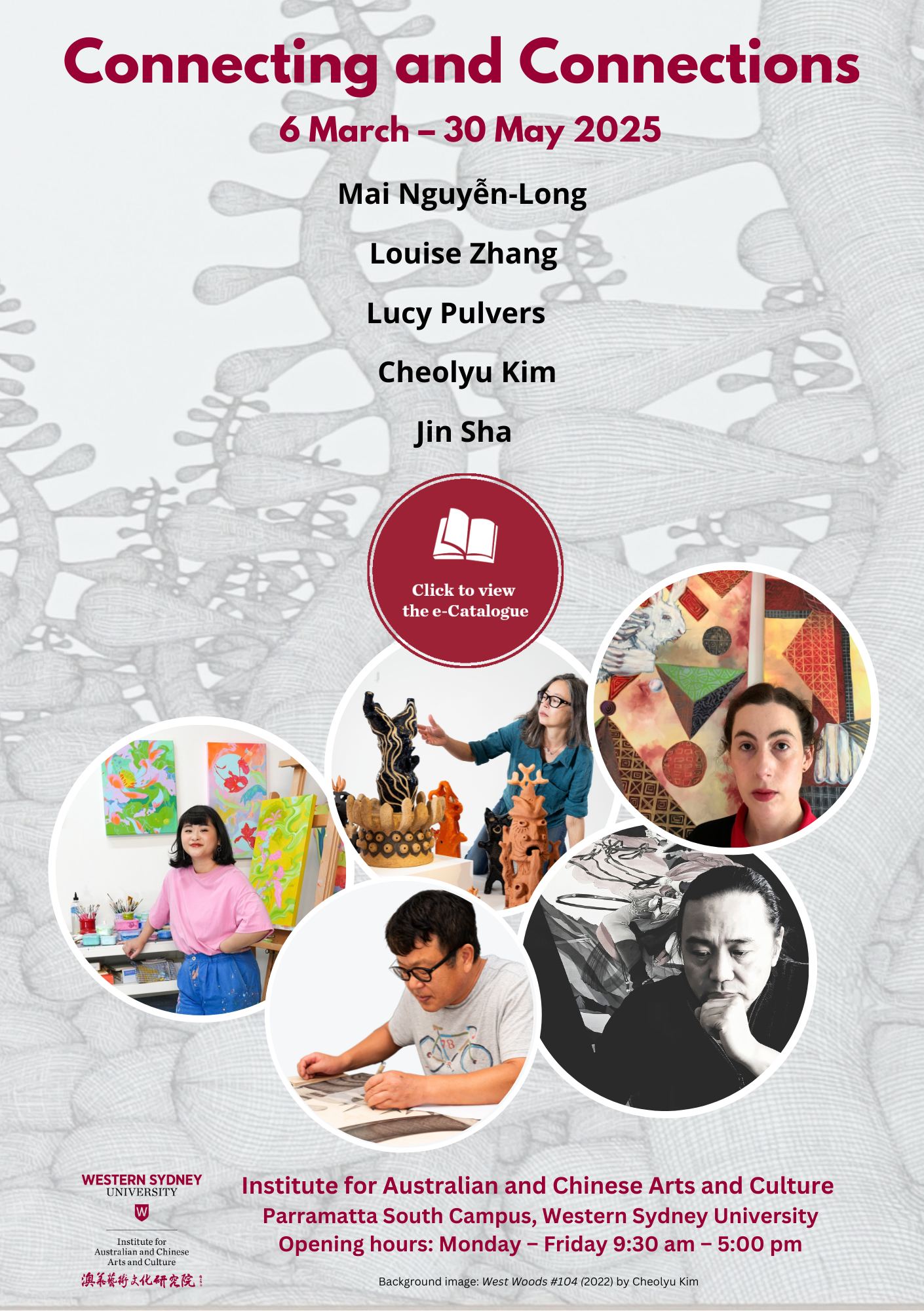Connecting and Connections
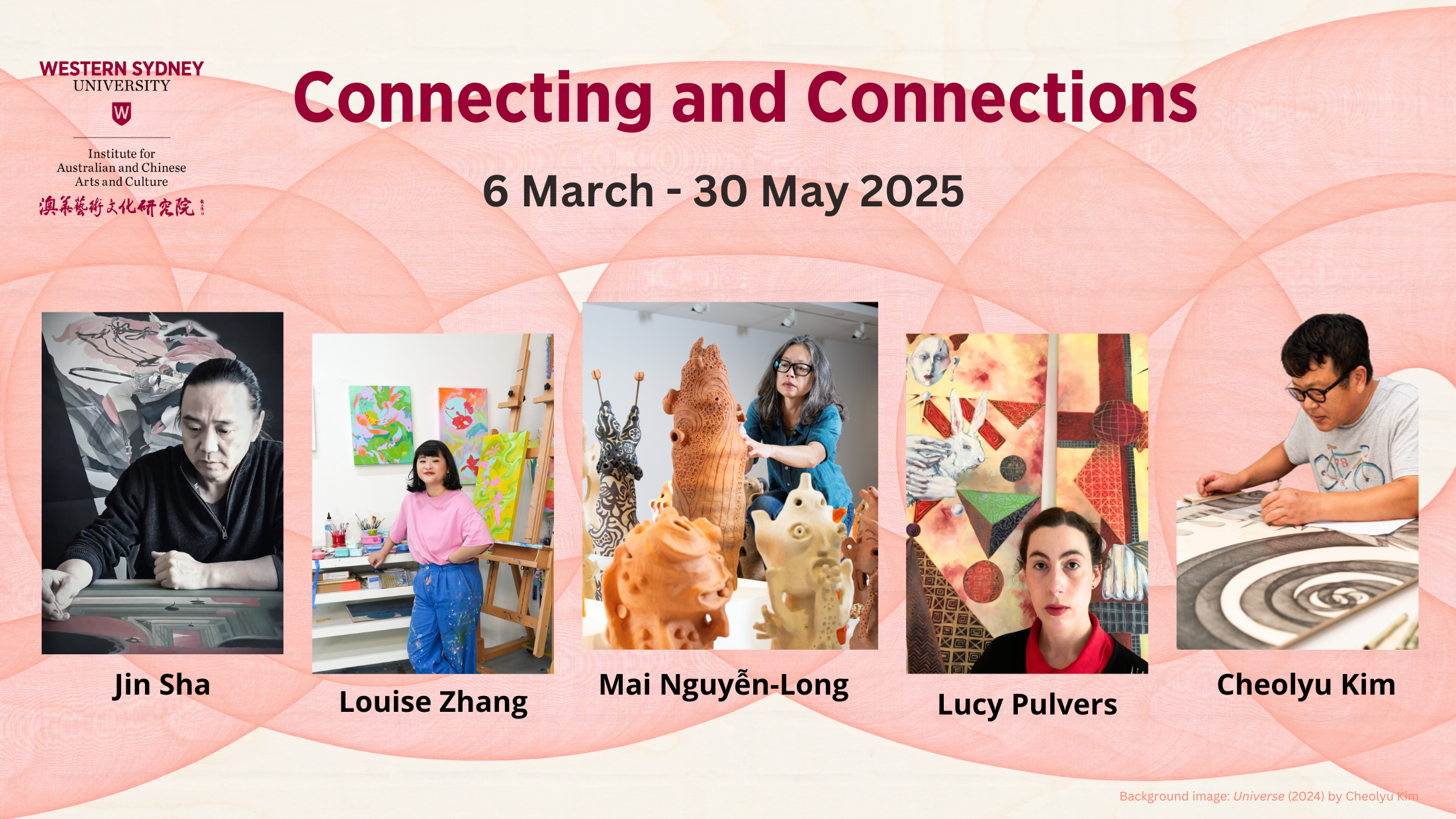
Exhibition Details
Date: 6 March to 30 May 2025
Venue: Institute for Australian and Chinese Arts and Culture, Building EA, Parramatta South Campus, Western Sydney University
171 Victoria Road, Rydalmere
Gallery Opening Hours: Monday – Friday (9:30am – 5:00pm)
Contact: lindsay.liu@westernsydney.edu.au
The Institute for Australian and Asian Arts and Culture (IAC) at Western Sydney University is excited to open its program scope to all Asian arts and cultures, to reflect and showcase a multilingual and multicultural contemporary Australia and promote exchanges and much needed interconnections among diverse cultures. Connecting and Connections, the first art exhibition of 2025, brings together five distinguished artists of diverse backgrounds who through their highly personalised and distinctive artistic creations, individually and collectively, explore the complexities—often layered and contradictory—of cultural heritage, identity, traditions, mythologies, art history and alternative perspectives. Their inspiring artworks invite viewers to engage with the myriad experiences that shape our world, expanding the mind's eye.
Mai Nguyễn-Long, an artist, academic and storyteller, was born in Tasmania to a Vietnamese father and an Australian mother and spent her formative years in Papua New Guinea and the Philippines. Her reconnection with the rich cultural heritage of Vietnam through an artist residency in the ceramic village of Bát Tràng led her to clay and the residence experience has influenced her art practice profoundly. Her work explores themes of belonging, identity, displacement, voicelessness, cultural erasure and the complexities of diasporic experience. The works featured in the exhibition span a variety of mediums, including drawing, painting, video and sculpture, revealing the intricate and evolving nature of her captivating body of work.
Louise Zhang is a Chinese Australian multidisciplinary artist. As a “third culture kid” growing up in Australia, she was fascinated with and intrigued by Chinese mythology and botany, and horror cinema. By drawing inspiration from Chinese folklore and traditional beliefs, while blending elements of Western pop culture and surrealism, she has created a unique and unmissable visual language. Her art practice explores a sense of otherness in identity, cultural hybridity and the interplay between beauty and horror, challenging traditional aesthetic boundaries and inviting viewers to question their perceptions of beauty and grotesqueness, identity and cultural belonging. Her work reflects on the spiritual dimensions of existence.
Lucy Pulvers is a Sydney-based artist renowned for her emotive figure paintings and portraits, imbued with surrealistic features, in oil and watercolour. Born and raised in Japan, she moved to Sydney in 2001. Her bilingual and bicultural background in Japanese and English has played a significant role in shaping her artistic practice. Japanese aesthetic culture, along with traditional Japanese figure painting and portraiture, has had a strong influence on her style. She also draws inspiration from Kabuki and Noh theatre, where climaxes are often conveyed through dramatic, exaggerated frozen poses. Her work blends emotional intensity with abstraction, evoking a sense of mystery and otherworldliness.
Cheolyu Kim was born in South Korea and received his fine art education in sculpture both in Seoul and New York. His work has been widely exhibited in Korea, Australia, Indonesia, New Zealand and the United States. Growing up in a mountainous village, Kim developed a deep fascination with the concept of flight which he symbolises as a yearning to transcend physical limitations in his art. His exquisite pen drawings, executed on either paper or wood, emerge from the interplay between memory, imagination, and dreams, effectively dissolving the boundaries between the real and the fantastical. This process allows Kim to explore and articulate life’s complexities, providing a means for personal reflection and understanding.
Jin Sha is a Chinese-born Australian artist who lives and works in Beijing and Sydney. He has superb mastery of the traditional Chinese painting technique called gongbi (工筆) , and is internationally renowned for his contemporary Chinese ink painting. By blending traditional techniques with a contemporary twist, Jin boldly reimagines art history, placing classic Renaissance paintings within a Chinese artistic setting. This innovative fusion of Eastern and Western art challenges our notions of identity, power and temptation. His work highlights a key feature of traditional Chinese painting: “leaving blank space”. This concept creates a thoughtful equilibrium with the filled spaces, eliciting an ethereal illusion.
Connecting and Connections showcases and celebrates the diversity of art and these five artists from different cultural backgrounds, challenging norms and perceptions while offering deep insight into the human experience. It inspires a greater appreciation of the interconnectedness of humanity, encouraging viewers to embrace the transformative power of art and creativity.
About Artists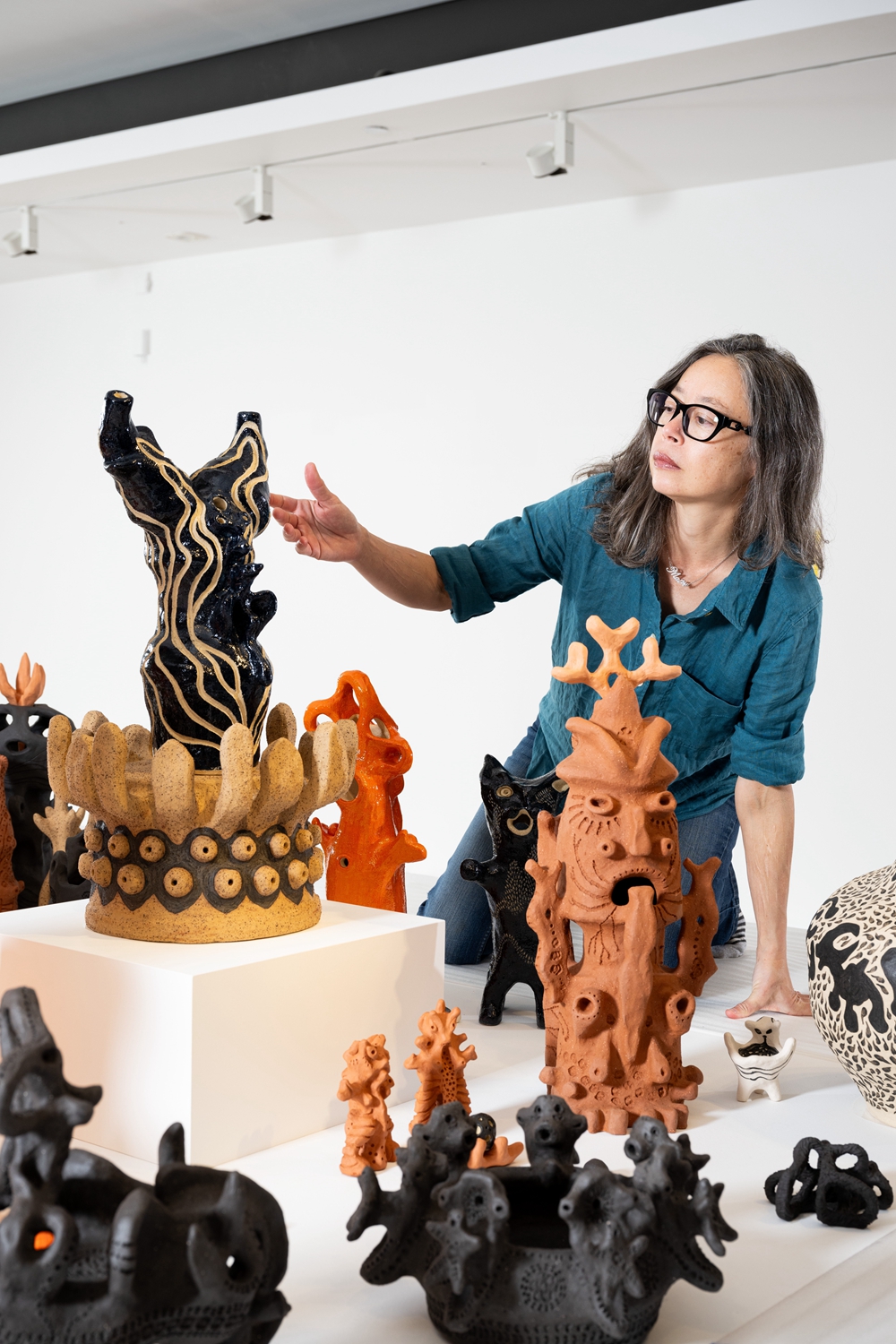
Mai Nguyễn-Long is an artist, academic and storyteller whose transient upbringing informs the tapestry of narratives that live through her work. Born in Tasmania to a Vietnamese father from Sa Đéc in Đồng Tháp province and a 4th generation Australian mother of Irish-Samoan descent, Nguyễn-Long’s formative years were spent living in Papua New Guinea and the Philippines.
Nguyễn-Long’s early academic commitments included Asian Studies, Art History, and Museum Studies. These experiences led to her work with an international health organization, becoming a 1999 Australian Youth Ambassador for Development with the Ministry of Health in Fiji. Since 1996 Mai has exhibited across a range of mediums including painting, drawing, media, mixed media sculptures and installation. In 2006 Casula Powerhouse Arts Centre commissioned ‘Phở Dog’, a work which would later have seminal impact on the development of her future creative practice.
As an adult, Nguyễn-Long lived in Australia and China. However, it was her reconnection with Vietnam that has had the most profound influence on the aesthetic and theoretical direction of her art. In 2015 a Copyright Agency Cultural Fund residency in the Hanoi ceramics village of Bát Tràng introduced Mai to clay. In 2023 she completed a practice-based doctoral program with her PhD thesis titled Vomit Girl Beyond Diasporic Trauma: Interconnecting Contemporary Art and Folkloric Practices in Vietnam at the University of Wollongong.
In 2022 she received much acclaim for her work in the 12th Berlin Biennale for Contemporary Art, with her newly commissioned ‘Specimen (Permeate)’ and ‘Vomit Girl (Berlin)’ clay sculptures. Curated by Kader Attia, the curatorial focus was decolonisation and repair. The 11th Asia Pacific Triennial for Contemporary Art at QAGOMA is currently exhibiting Nguyễn-Long’s most ambitious installation to date, titled ‘The Vomit Girl Project 2024’. The artist now lives and works in Dharawal country, Bulli, and is represented by Michael Reid Sydney + Berlin.
Artist Statement
My practice upholds a sense of flux where multiple histories can be considered without dishonouring my own narratives and blind spots.
In the context of a confused sense of belonging, the search for my Vietnamese identity has driven my arts practice through various methods of interrogation. Between the 1990s and 2000s, this swung from oppositional visual structures to an outright rejection of my ‘non-Australian’ selves.
Until I discovered clay, drawing was always a staple of my practice. Vomit Girl first appeared to me in drawings, and, refusing to go away, I was forced to engage with her. Drawing and clay are bodily languages. They have become a way of processing everyday life, the times we live in. Clay bypasses my overly rationalised self-edit impulse.
It was my eventual ‘reconnection’ with Vietnam that introduced clay to my practice through a 2015 chance residency in the ceramic village of Bát Tràng. The innate nature of clay came to uphold my conceptualisation of mộc mạc as spiritual resilience, echoing its historical links to Vietnam’s struggle for independence. Whilst I realised I could not be a ‘real’ Vietnamese, I could still embrace a personalised conceptualisation of mộc mạc - a sensibility I encountered through Red River Delta đình woodcarvings, to construct a sustainable strategy for creative grounding as an aesthetic for spiritual functionality. Clay and mộc mạc then opened new imaginings for continuous transformation.
Why do I continue to use clay? Clay is conducive to challenging my preconceived notions, altering relationships with uncomfortable realities. Clay’s dualities of strength and vulnerability sustains my interest in possibilities for non-exclusive traumas. The haptic process of clay interconnects otherwise discombobulated realms of my physical, emotional, mental being. It reminds me I am part of a much larger universe of which humans are not the centre.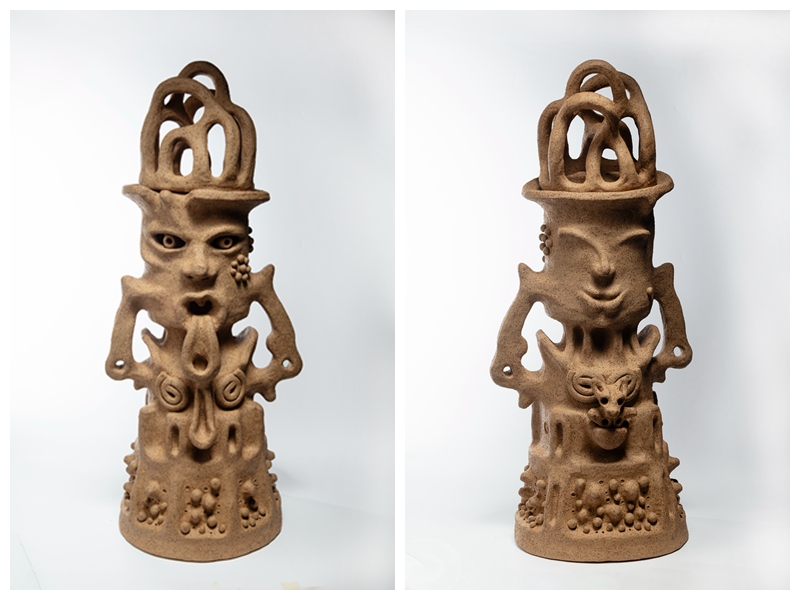
Vigit Hefeco 4 (with Worana hat and pocket mini) AWAD144
2023
Heavily grogged large particle clay fired to 1220
75 x 32 x 22 cm
Courtesy the artist and Michael Reid Sydney + Berlin
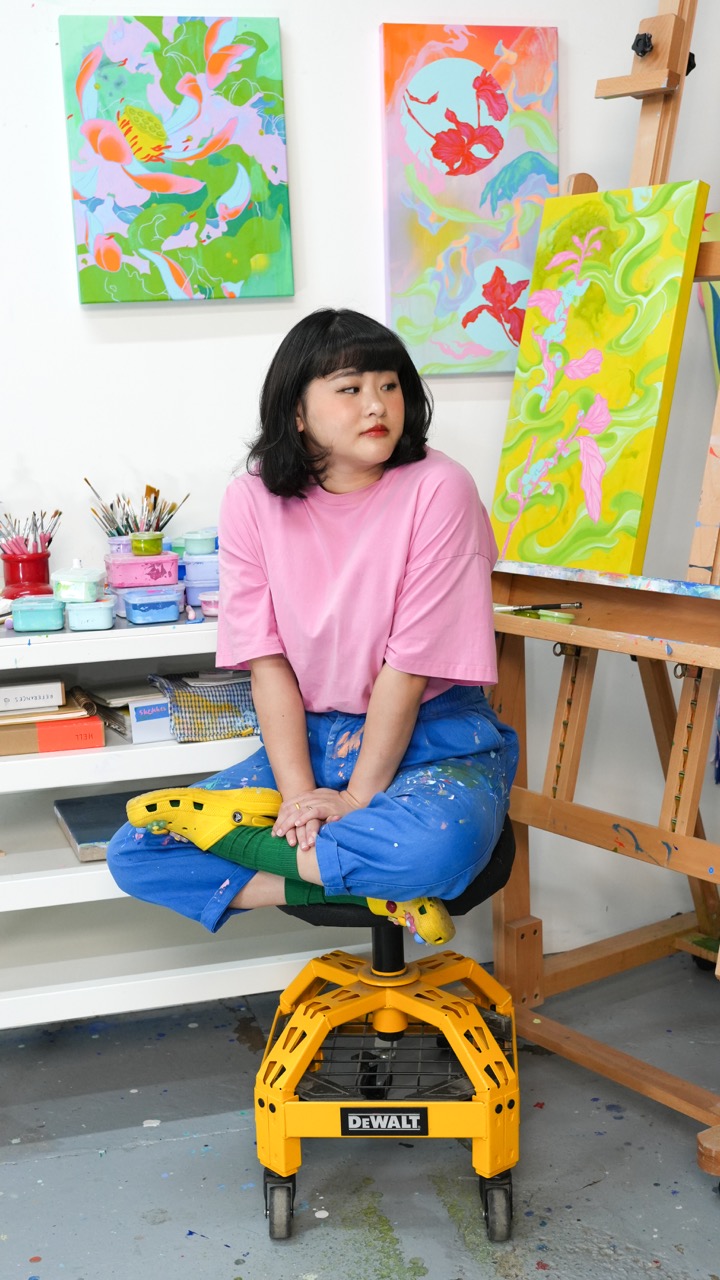
Louise Zhang 张露茜 is a Chinese Australian multidisciplinary artist whose practice explores the dynamics of aesthetics, contrasting the attractive and repulsive in order to navigate the senses of fear, anxiety and a sense of otherness reflecting her identity.
Zhang's work is inspired by horror cinema, Chinese mythology and botany, adopting and placing symbols and motifs in compositions of harmonic dissonance. Her practice explores Chinese mythology – paintings, sculptures and scroll-like banners that incorporate demons, dismembered body parts and organs drawn from anatomy books – overlaid with illustrations of flowers, bones, scholar rocks and auspicious imagery presented in a sugary palette. The aim is to create a visual cacophony, a disjointed and disorientating mash-up of symbols and imagery in an attempt to in part reconcile and make sense of the fissures and contradictions that define her own identity.
As a ‘third culture kid’ with a strict Chinese-Christian upbringing, engaging with or learning about the superstitions that form such an inherent part of Chinese mythology and culture was, and at times still is, understandably, discouraged. Likewise, her teenage love of western horror films and gothic subculture, and her art making practice in general, were derided by her Chinese-Christian community as being sources of anxiety and depression at the time. By researching and integrating these seemingly disparate sources of artistic inspiration into her works, Zhang documents her attempts at both constructing and deconstructing her own personal and cultural identity. Louise Zhang is represented by N.Smith Gallery.
For interest in collection, please visit: https://privateviews.artlogic.net/2/b4c93593208f35f502bc32/
Artist Statement
Inspired by my recent trip to China, these paintings offer a deep exploration of cultural heritage, personal identity, and transformation. Through a delicate blend of tradition and surrealism, I invite viewers to slow down and linger in a space of contemplation where the familiar and foreign, past and present, intertwine.
In my practice, I reimagine architectural forms and weave in text-based works to recontextualise chinoiserie, reflecting on the complexities of third-culture identity, alienation, and rediscovery. The intricacies of the afterlife, ancestral connections, and religious beliefs subtly emerge throughout, evoking a sense of continuity between generations and providing a space for meditative reflection on the spiritual dimensions of existence.
These works are a meditative invitation to connect with my art on a deeper, more personal level.
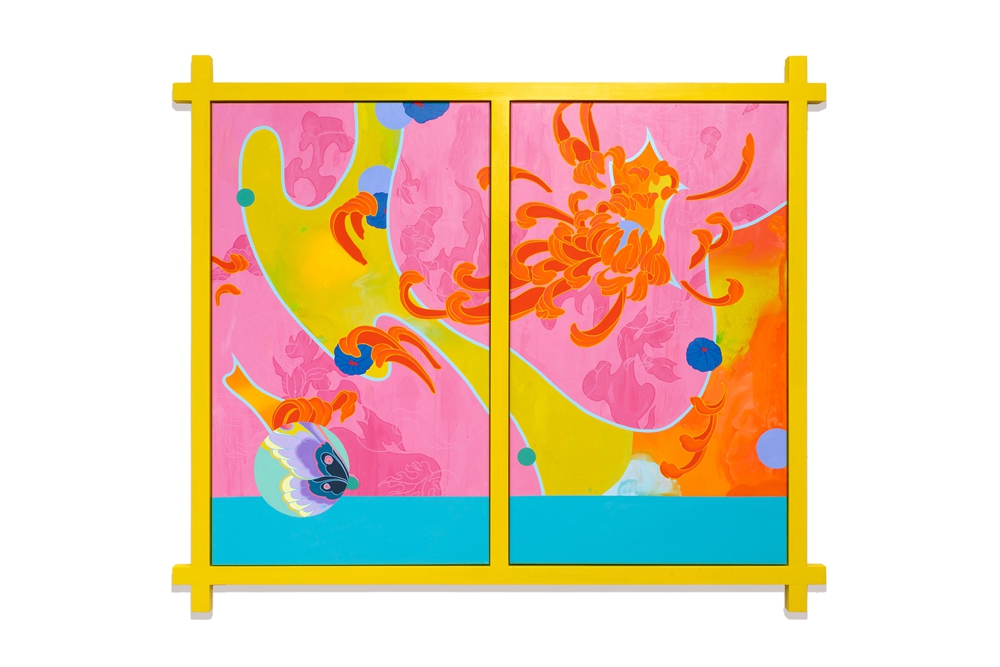
Healing Towards Transformation (Chrysanthemum and Butterfly)
2024
Acrylic on linen
101 x 120 cm
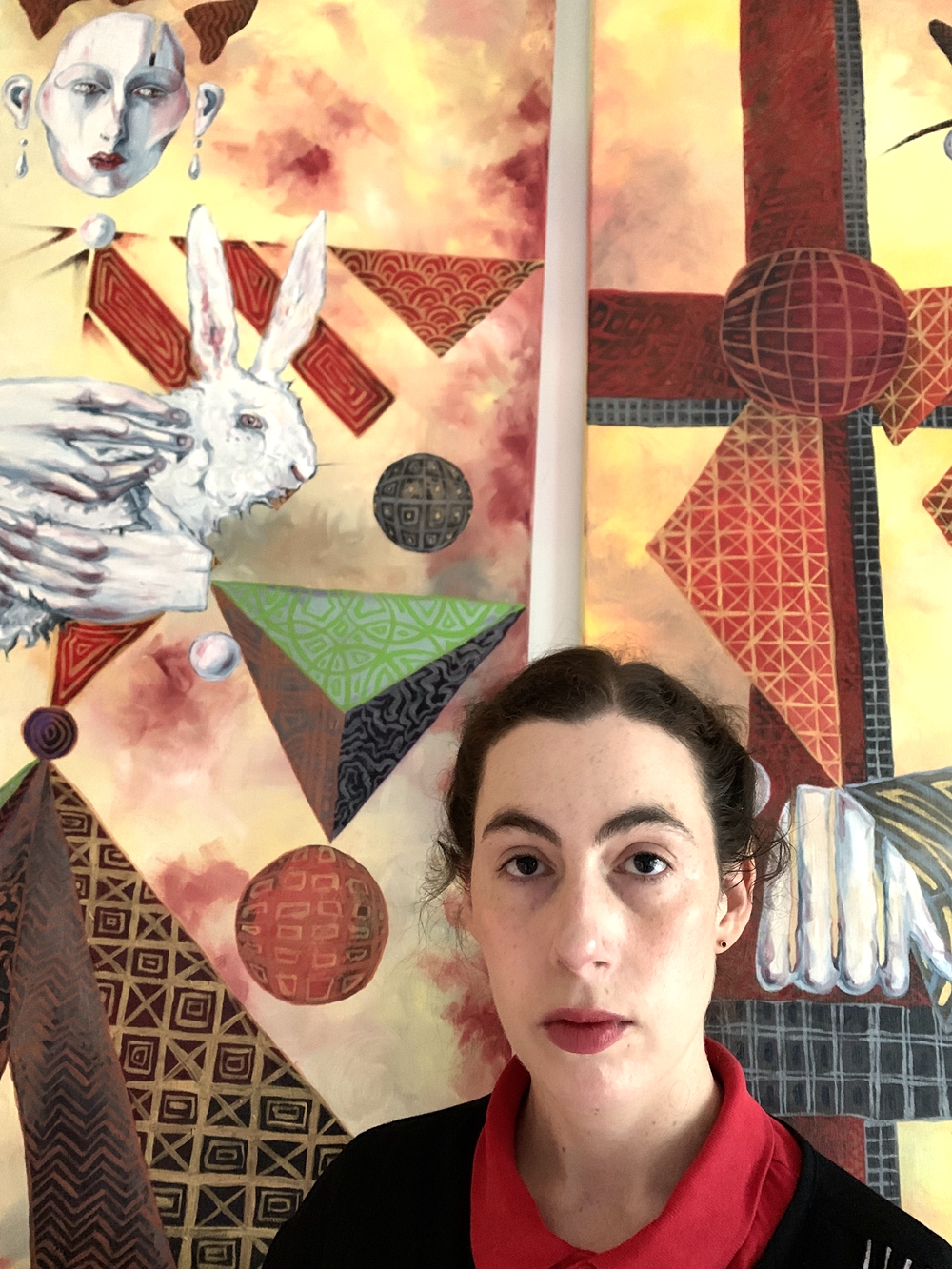
Lucy Pulvers was born in Kyoto, Japan and grew up in both Tokyo and Kyoto with her two elder sisters, also artists, and her elder brother. She was educated in Japanese schools until she moved to Sydney in 2001 and is bilingual and bicultural in Japanese and English. In 2014 Lucy was awarded the Thea Proctor Scholarship by the Julian Ashton Art School. Lucy paints in both oil and watercolour. When Lucy was living and working in London in 2019, she began exhibiting her watercolour paintings in the annual Royal Institute of Painters in Watercolours exhibition in London. Lucy has exhibited with the institute every year since then and in 2020 she was awarded the ‘President’s Choice Award’ for a self-portrait. In 2024 she won the ‘Anthony J Lester Art Critic Award’.
Lucy exhibits regularly and has been a finalist twice in the Portia Geach Portraiture Prize, a finalist in the Mosman Art Prize, a semi-finalist in the BP Portraiture Prize in London and a finalist in the Blake Prize.
Lucy is essentially a figure painter. All her artistic work is rooted in her relationship to line and drawing as the foundation of her works, both in watercolour and oils. Japanese aesthetic culture has had a major impact on Lucy's work, where she spent her childhood, and began to develop as an artist. Lucy Pulvers is represented by Rochford Gallery.
Artist Statement
In many traditional Japanese figure paintings and portraits the face and hands are the elements that give expression to the inner life of the figure. My paintings are all, in essence, an exploration of the inner life of human beings. I like to use geometry, strong colour and bold lines to give my works an emotional power. These elements of colour and line are woven together to synthesise a surface world which captures a moment in the inner life of the figure portrayed. The clothing of the figure, however, is often full of volume, geometry, colours and symbols which tell the story of the figure. I have always been fascinated by Kabuki and Noh theatre, where emotional climaxes in the drama are often expressed in frozen moments. The ‘mie’ in Kabuki occurs when the actor poses motionless but with extreme energy, bathed in dramatic lighting so the whole theatre holds its breath in the moment. I am now consistently producing works in oil on linen and I enjoy being able to express myself in much larger compositions.
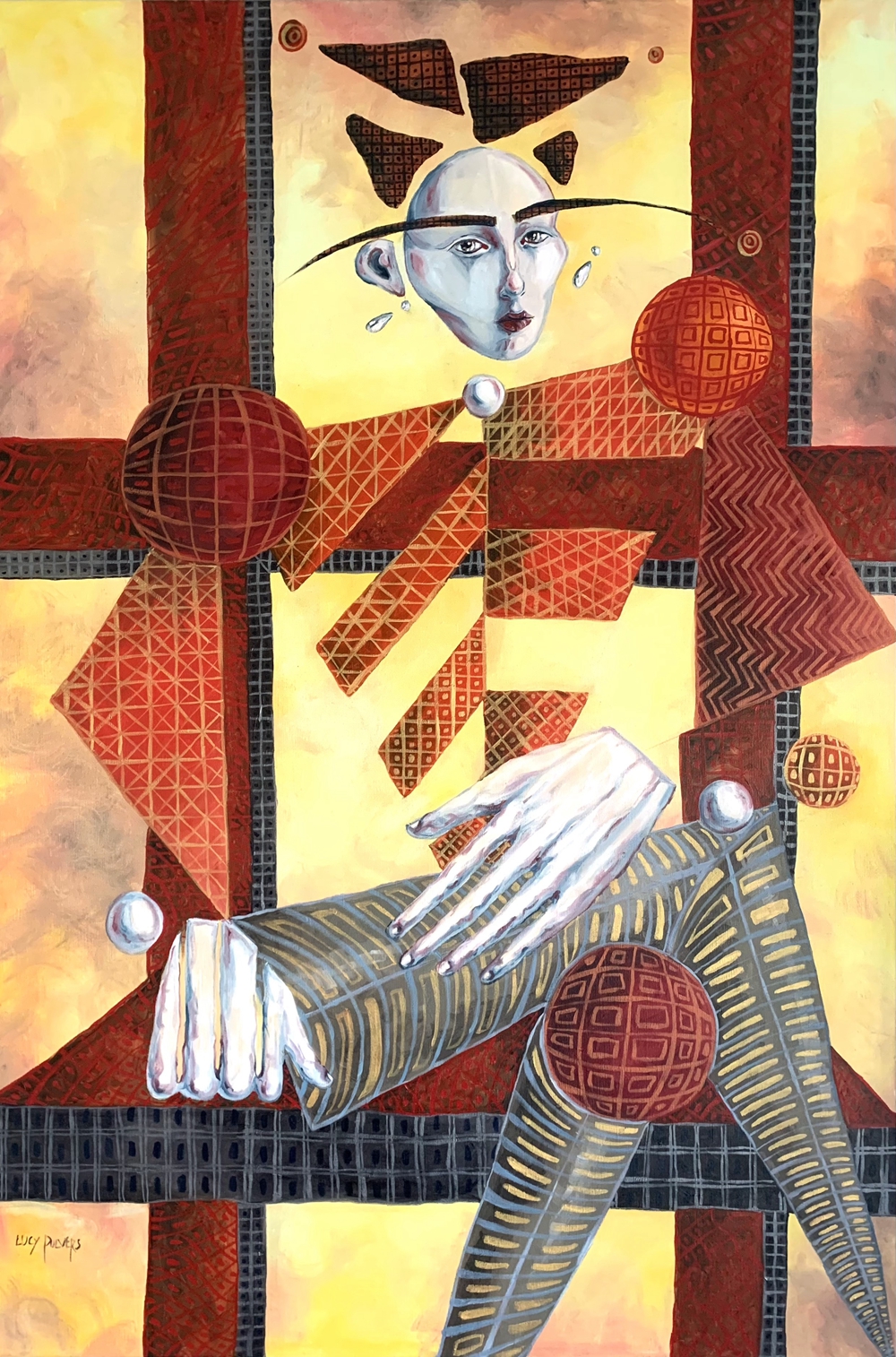
Adagio
Oil on linen
2024
152 x 101 cm
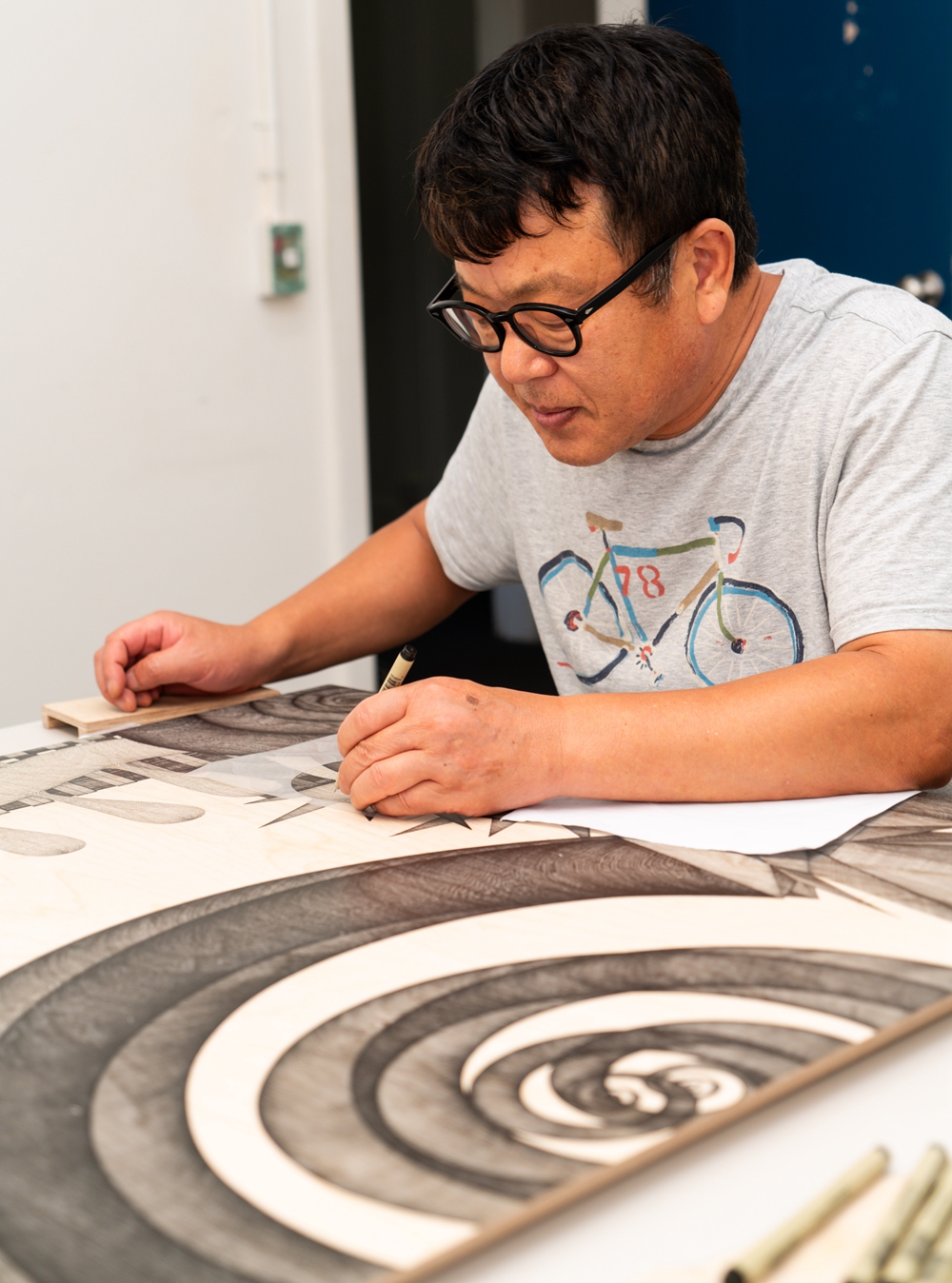
Cheolyu Kim was born in South Korea. He received his Master of Fine Arts in Sculpture from Brooklyn College in New York and a Bachelor of Fine Arts in Sculpture from Chung-Ang University in Seoul.
Since childhood, Kim has been deeply fascinated by the concept of flight, whether through seeds, leaves, insects, birds, balloons, planes, or even UFOs. Early experiences included hours spent following colourful balloons from the North, which carried political leaflets, and chasing various airborne objects. These formative encounters have significantly shaped Kim's dreams and artistic practice. In dreams, Kim often grappled with transparent flying dishes attacking their village or imagined navigating the skies. Despite an awareness of lacking wings, Kim simulated flight with his arms, symbolising a yearning to transcend physical limitations. This pursuit of transcendence led Kim to invest considerable effort in establishing personal parameters and interpretations through visual imagery. Kim's artwork emerges from the interplay between memory, imagination, and dreams, effectively dissolving the boundaries between the real and the fantastical. This process allows Kim to explore and articulate life’s complexities, providing a means for personal reflection and understanding. By navigating the intersection of the familiar and the unfamiliar, Kim’s work creates a dialogue between these realms, facilitating a deeper engagement with both.
Cheolyu Kim’s artworks have been widely exhibited in Korea, Australia, Indonesia, New Zealand and the United States. Cheolyu Kim is represented by Redbase Gallery.
Artist Statement
“When I was young, my parents bought me a Spirograph. It was a set of circular analogue mechanical devices with interlocking geared teeth. When inserting a coloured pen, one could construct a continuous line of circles that crisscrossed the paper endlessly, making new worlds in intergalactic space. This spirograph gave me hours and days of innate pleasure as I journeyed into the imaginary spaces of the fantastic and dreams that only occurred in the weird worlds of sci-fi. Looking back, it was absorbingly interesting because it removed me from the real world into an unknown and uncanny new world that was improbable. Of course, my parents gave it to me as it suggested geometric and mathematical educational learning and did not fathom that what it actually did was introduce me to fantastic, almost hallucinatory new invented worlds of impossible architecture, composed only of lines and imagination, to an imaginary that was beyond the capacity, the gravity and the reach of the real.”
With a background in sculpture, this influence is evident in the carved-like volumes within his drawings, where he employs techniques such as fine moire and cross-hatching for textures and shading, often leaving the paper or wood exposed in other areas.
Currently, Kim’s artistic focus is entirely devoted to pen drawing, executed on either paper or wood. Whether utilising a bicoloured or monochromatic palette, his work is characterised by detailed compositions, tonal gradients, and multiple perspectives, achieved through a deliberate restriction of chromatic range.
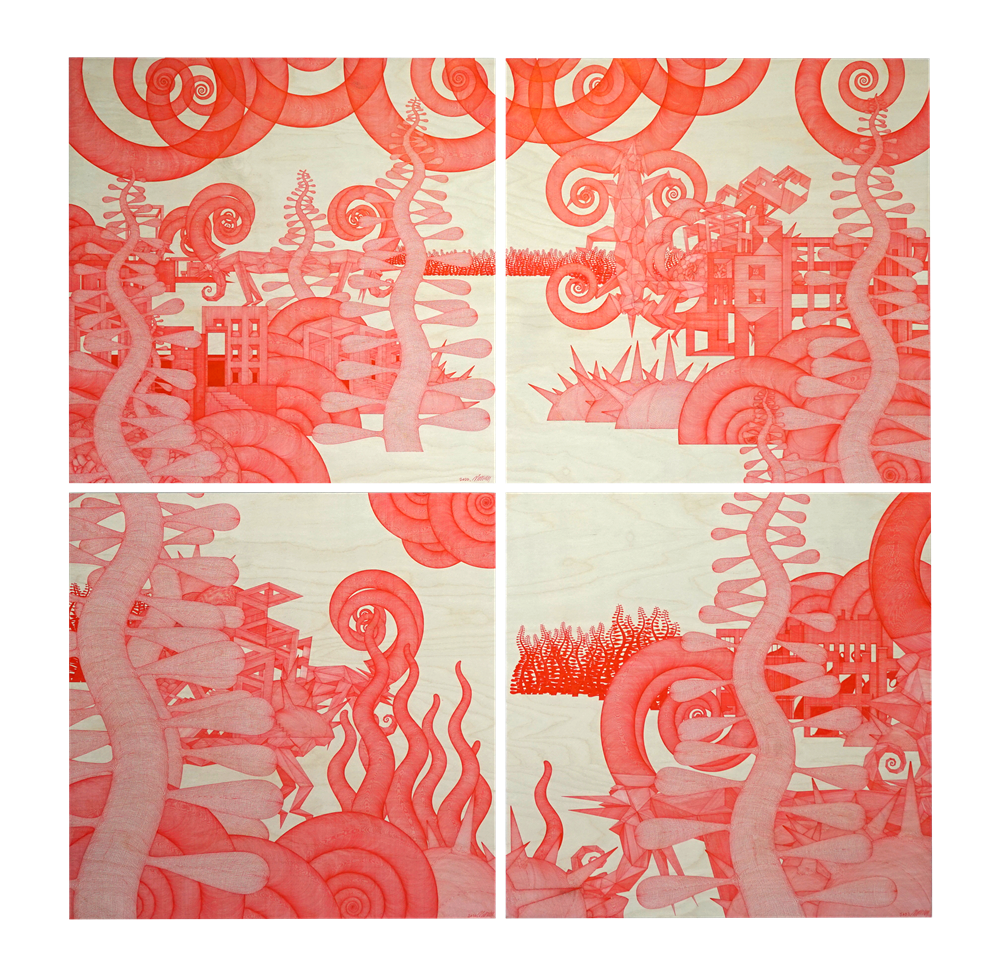
A Midsummer Day Dream 5, Long Road to Home
Pen on birch wood panel
2022
60 x 60 cm each
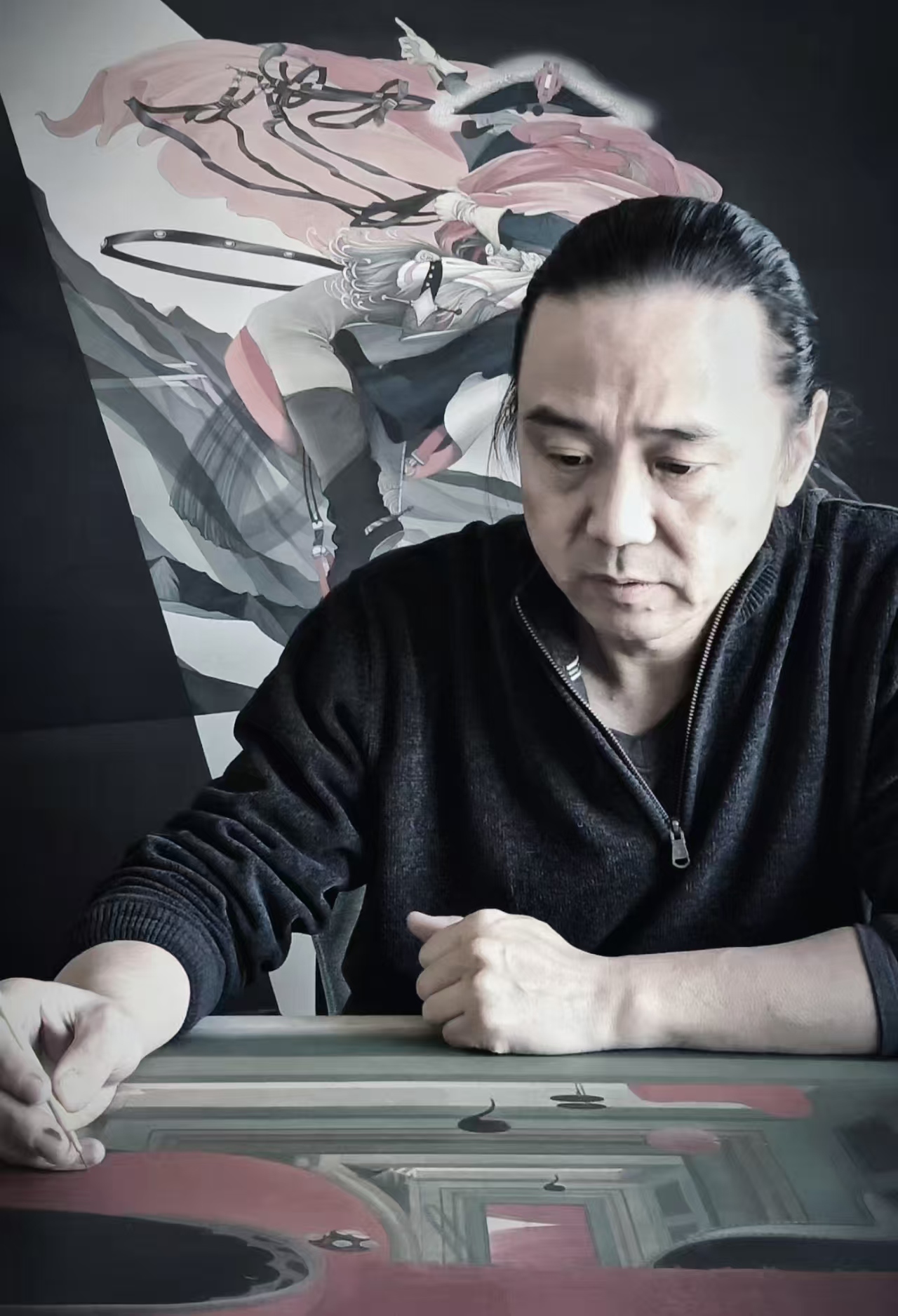
Jin Sha is a Chinese-born Australian artist who lives and works in Beijing and Sydney. A graduate from the Central Academy of Fine Arts (CAFA), China, Jin is an internationally renowned artist in contemporary Chinese ink painting. His paintings showcase his signature style: a perfection of realistic painting techniques of linear perspective and three-dimensional modelling often found in Renaissance oil and tempera painting. He has a superb command of traditional Chinese painting technique: gongbi (工筆), applying precise brushstrokes to create detailed images. Jin uses ink and watercolour on silk, combining fine lines with multiple layers of both ink-shadings and colours to achieve the three-dimensional effect. By blending traditional techniques with a contemporary twist, Jin boldly reimagines art history. This innovative fusion of Eastern and Western art challenges our notions of identity, power and temptation. With a unique approach, Jin Sha initiates a conversation between tradition and innovation by skillfully delving into canonical Western art through gongbi, the known meets the unknown in a thought-provoking blend.
Jin has exhibited extensively in China, Australia, the United States and Japan. Jin Sha is represented by Redbase Gallery.
Artist Statement
I believe that an artist’s task is not only to express how they perceive and feel about human and social issues in an artistic way, but also to peel back the surface to explore deeper spiritual connections of the world they see. In creating a work of art, the artist, like a conspirator, plants all sorts of subtle clues in the work, enticing the viewer to search for clues and to solve the mystery.
The Renaissance has created a magnificent pinnacle of art, culture and humanity. My “Tribute to the Masters” series places the classic paintings of the Renaissance in a Chinese artistic setting to interrogate the current situation, focusing on a range of impacts that global mobility and rapid economic development have had on human life. We live in a world that is full of temptation and materialism, greed and desire for power, which has turned our once splendid culture into a commodity. This growing trend of commodification is spreading rapidly with globalised consumerism and has become a great cause for concern.
A key feature of traditional Chinese painting is the deliberate use of “negative space”. The concept of “leaving blank space” is to establish a thoughtful equilibrium with the filled spaces and create an ethereal illusion. So in my paintings, I have deliberately removed the faces and bodies that characterise the original masterpieces, so that the viewer’s mind is not distracted by these familiar images, allowing audiences to join the conversation and freely express their opinions and giving them space to re-imagine visual elements and their meanings. Meanwhile, I have retained the perfect ambience in the original works to enable viewers to seek and find connections in a simultaneously familiar and unfamiliar visual world.
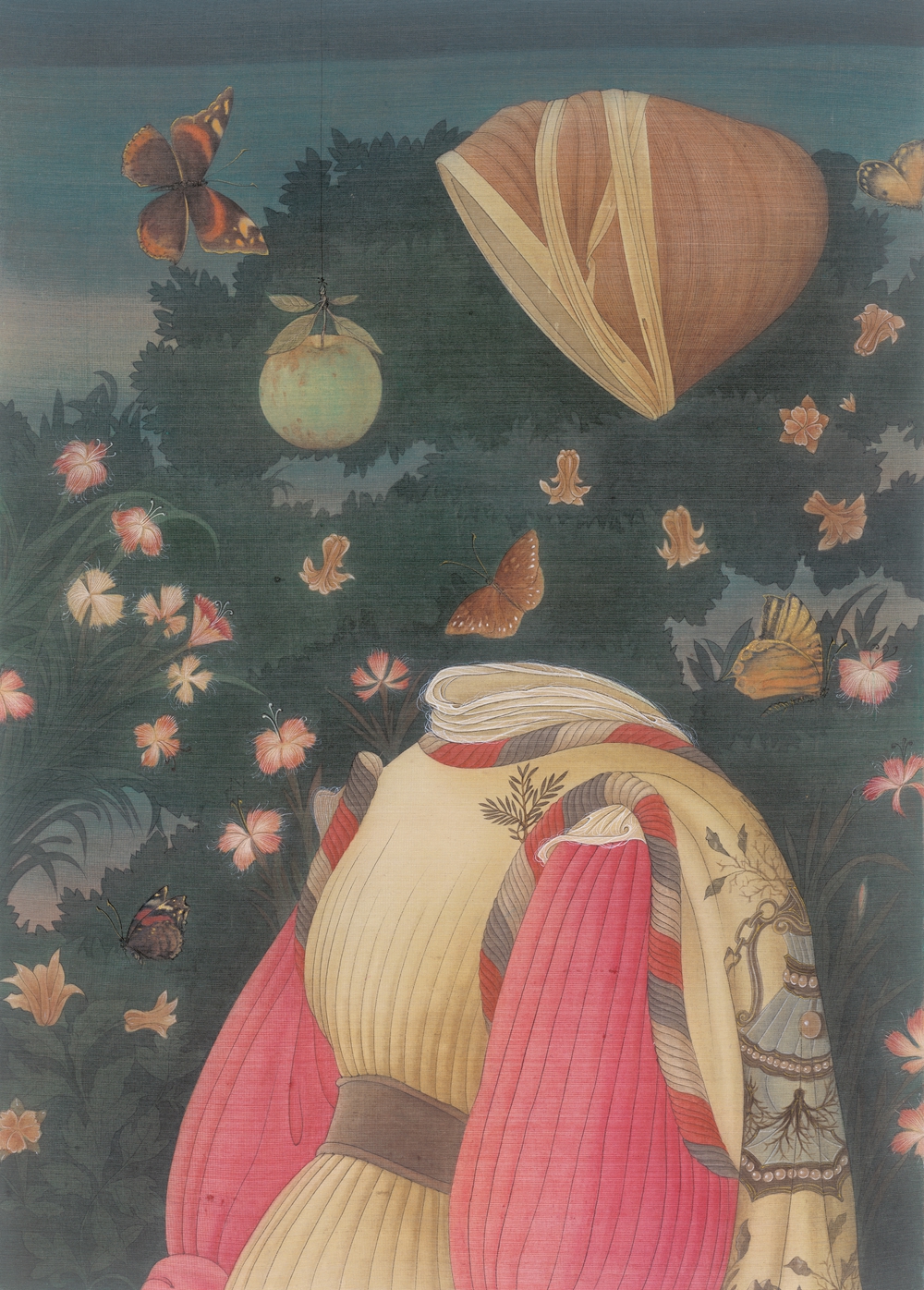
Conversation with Pisanello
2012
Ink and colour pigment on silk
60.5 x 43.5 cm
Opening Photo Gallery
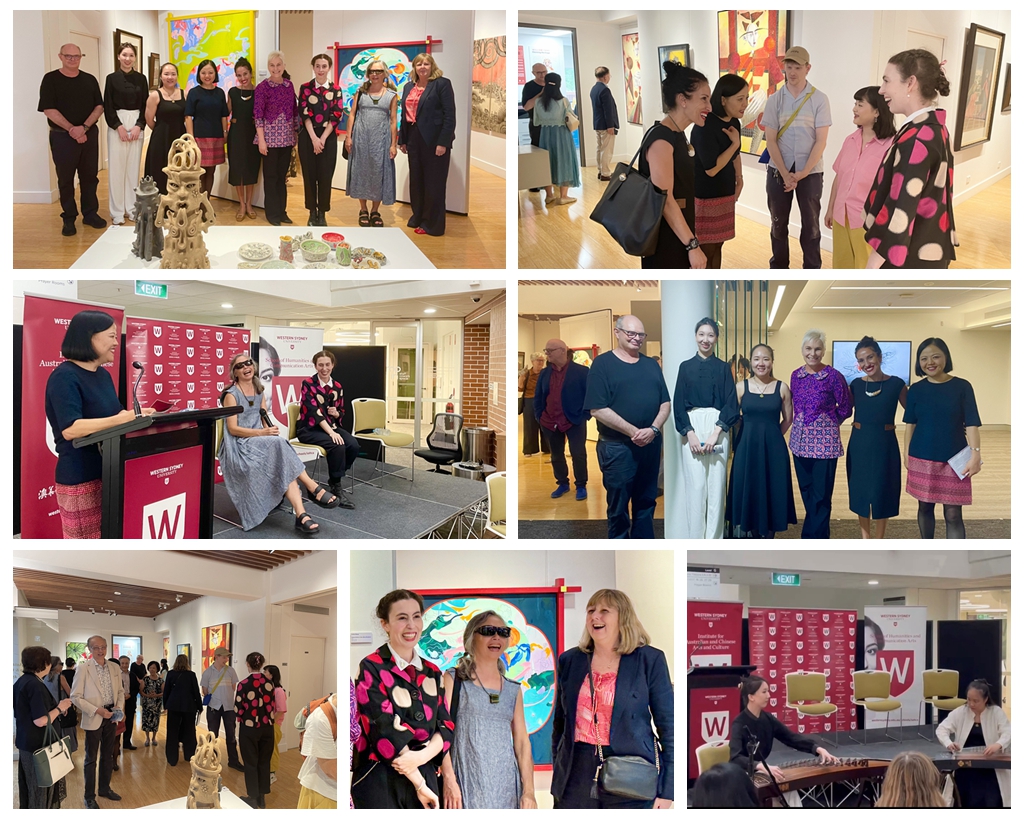
Opening Sponsor

